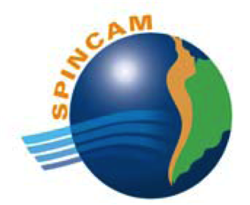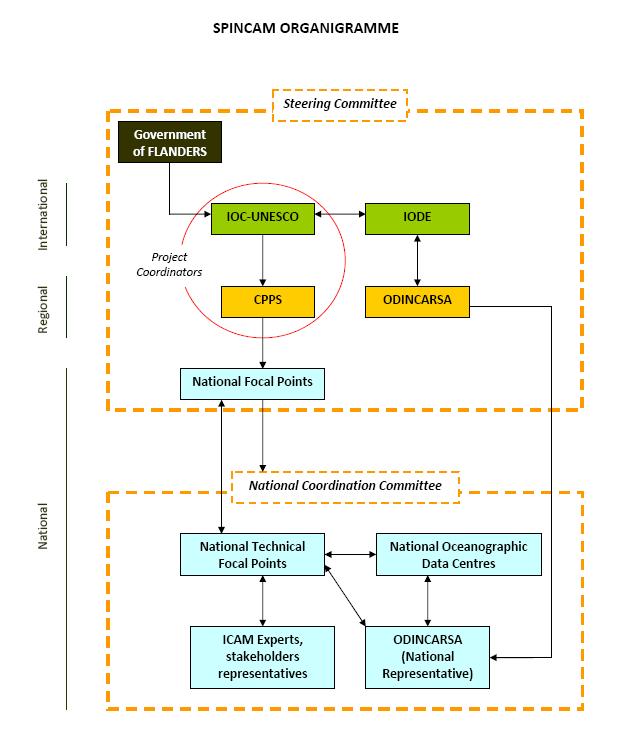Southeast Pacific data and information network in support to integrated coastal area management (SPINCAM)
see the SPINCAM movie
The SPINCAM Project is currently in its third phase of implementation (SPINCAM III). It is developed under the general coordination of IOC-UNESCO and with the regional coordination by the Permanent Commission for the South Pacific (CPPS). SPINCAM I started in 2009 and SPINCAM II in 2012.
SPINCAM is designed to establish a framework of integrated coastal management indicators at the national and regional levels in the countries of the South Pacific region (Chile, Colombia, Ecuador, Panama and Peru) focusing on the state of the coastal and marine environment and socio-economic conditions. The indicators and coastal spatial data available are published in the form of atlases and data repositories at the national and regional levels, with the aim of supporting an integrated coastal area management (ICAM) and development practices for sustainable use. Special attention is drawn to communicating indicator-based information to a wider audience, through the development of fact sheets and score cards on each indicator and the development of a State of Coast report/Coastal Atlas at national level. The project focuses primarily on national priorities and requirements, while seeking to benefit from regional networking and the development of regional and national products and services.

SPINCAM III aims to lay the foundations of a long-term strategy to support sustainable growth of coastal, marine and maritime areas, recognizing the importance of these settings as drivers of the regional economy, with great potential for innovation and growth in line with the Convention for the Protection of the Marine Environment and Coastal Areas of the Southeast Pacific, commonly known as the Lima Convention. With the Lima Convention, the Southeast Pacific countries pledged to make every effort needed to address pollution from land and marine sources, and to protect and preserve the fragile, vulnerable or unique natural or cultural value through proper ecosystem management of marine and coastal protected areas.
The aim of SPINCAM 3 is to develop a harmonized coastal and marine environmental management framework for the beneficiary countries in the Southeast Pacific, thereby providing the right tools to apply the ecosystem approach in their national waters, while also providing a foundation for planning sustainable economic development (blue growth) through inter-institutional capacity-building, which will translate into concrete recommendations and strategies at the regional level.
The project aims to improve the ecosystem management of the coastal and marine areas of the Southeast Pacific. Through a functional and sustainable regional mechanism the necessary framework and tools will be developed to help the participating countries adopt the practical recommendations during implementation of the project, with the aim to facilitate:
(a) development of a collaboration framework for coastal and marine management and planning in favour of sustainable national development, strengthening regional consensus, public participation and the existing SPINCAM network;
(b) technical and institutional capacity-building to reduce disparities between countries;
(c) development of methodological tools to support decision-making with the aim of increasing synergies to apply methodological concepts, for both integrated coastal management and marine spatial planning;
(d) development of local pilot cases through identification of the most representative actors and socio-economic players that define the potential of the local ecosystem as a basis for sustainable development and blue growth;
(e) development of regional and national strategies for coastal and marine management and planning in the context of the Lima Convention;
(f) design and implementation of communication products and initiatives that increase transparency in the promotion and involvement of the main actors and citizens in the activities of the project.
Through the institutional recommendations that are envisaged as final outcomes of this project, marine spatial planning will support a sustainable management of activities in the sea, and support the competent authorities in developing an integrated assessment of the state of the coastal and marine environment. This must lead to effective measures to fostering sustainable growth, taking into account the local environmental, economic, climatic, cultural and social factors.
SPINCAM I (2008-2012)
This Project aimed from its first phase to establish an ICAM indicator framework in each country of the Southeast Pacific region (Chile, Colombia, Ecuador, Panama and Peru), focusing on environmental and socio-economic conditions within the context of sustainable development and integrated coastal area management. The application of a harmonized methodology and the development of a set of indicators among the participating countries allowed for the calculation of a core set of common indicators at regional level. In addition, information systems were built at national and regional level, to support both the development of the indicators and dissemination of the results.
Its main objectives were:
- To support the implementation and effectiveness of ICAM through the improvement of data and information management capacity, knowledge, communication and networking at regional and national level;
- To improve the delivery of data and information on the status of coastal resources and their management for the use by all coastal stakeholders (decision makers/civil society);
SPINCAM II (2012-2016)
SPINCAM II supported the implementation and sustainability of ICAM in the region, and national decision-making processes by identifying baselines and ecological and socio-economic trends in the use of coastal resources in order to define future strategies to deal with global changes.
The countries involved in SPINCAM focused on formulating new regional indicators and consolidating the indicators identified in the first phase. In SPINCAM II, the updating of products and information has continued, including the integration of national indicators in the national atlases. Intensive capacity-building was developed at national level to implement information systems and products to support coastal and marine management. From a global perspective, SPINCAM is providing an excellent opportunity to contribute to the establishment of an information mechanism on the state of the coastal and marine environment in the region, as required by the national reporting mechanism for coastal management in the region, in accordance with the Global Ocean Science Report (GOSR) and the regular process of the United Nations General Assembly through the Regular Process for Global Reporting and Assessment of the State of the Marine Environment, including socio-economic aspects.
SPINCAM Management Structure
